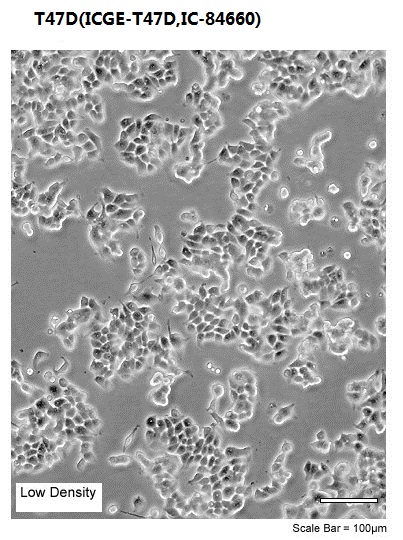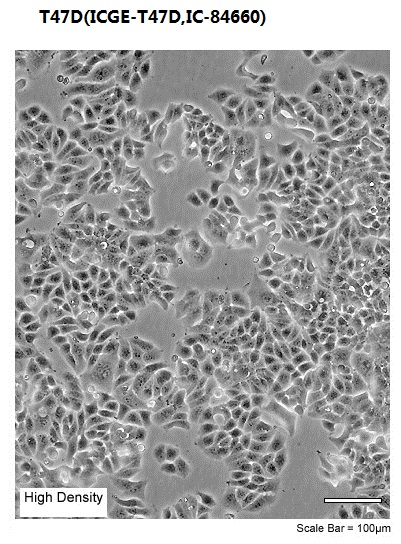


| Organism | Homo sapiens, human |
|---|---|
| Tissue |
mammary gland; derived from metastatic site: pleural effusion
|
| Cell Type | Epithelial |
| Product Format | frozen |
| Morphology | epithelial |
| Culture Properties | adherent |
| Biosafety Level |
1
Biosafety classification is based on U.S. Public Health Service Guidelines, it is the responsibility of the customer to ensure that their facilities comply with biosafety regulations for their own country. |
| Disease | ductal carcinoma |
| Age | 54 years adult |
| Gender | female |
| Applications |
This cell line is a suitable transfection host.
|
| Storage Conditions | liquid nitrogen vapor phase |
| Karyotype | This is a hypotriploid human cell line. The modal chromosome number is 65 occurring at 50% and polyploidy at 0.8%. 18 marker chromosomes are common to most cells, of which 7 are paired and 11 are single-copied. The t(8q14q), t(9q17q), t(10q17p) are among 7 paired markers common to most cells. N7, N9, and N10 are absent and N11 is generally present in 4 copies. DM''''''''s occurred, but infrequently. Q-band examination did not show the presence of a Y chromosome. |
|---|---|
|
|
|
| Derivation |
The T-47 line was isolated by I. Keydar from a pleural effusion obtained from a 54 year old female patient with an infiltrating ductal carcinoma of the breast.
|
| Clinical Data |
female
54 years
|
| Receptor Expression |
Receptor expression: calcitonin, expressed; androgen receptor, expressed; estrogen receptor, expressed; progesterone receptor, expressed; glucocorticoid receptor, positive, expressed; prolactin, expressed; calcitonin; androgen receptor, positive; progesterone receptor, positive; glucocorticoid; prolactin; estrogen receptor, positive |
| Effects |
Yes, forms colonies in soft agar
|
| Comments |
This differentiated epithelial substrain (T-47D) was found to contain cytoplasmic junctions and receptors to 17 beta estradiol, other steroids and calcitonin.
The cells express the WNT7B oncogene. Ref
|
| Complete Growth Medium |
The base medium for this cell line is ATCC-formulated RPMI-1640 Medium, Catalog No. 30-2001. To make the complete growth medium, add the following components to the base medium: 0.2 Units/ml bovine insulin; fetal bovine serum to a final concentration of 10%. Human insulin may also be used (Life Technologies, Catalog No. 12585-014). |
|---|---|
| Subculturing |
Volumes are given for a 75 cm2 flask. Increase or decrease the amount of dissociation medium needed proportionally for culture vessels of other sizes. Corning® T-75 flasks (catalog #430641) are recommended for subculturing this product.
Subcultivation Ratio: A subcultivation ratio of 1:3 to 1:5 is recommended
Medium Renewal: 2 to 3 times per week
|
| Cryopreservation |
Freeze medium: Complete growth medium supplemented with 5% (v/v) DMSO
Storage temperature: liquid nitrogen vapor phase
|
| Culture Conditions |
Atmosphere: air, 95%; carbon dioxide (CO2), 5%
Temperature: 37��C
|


